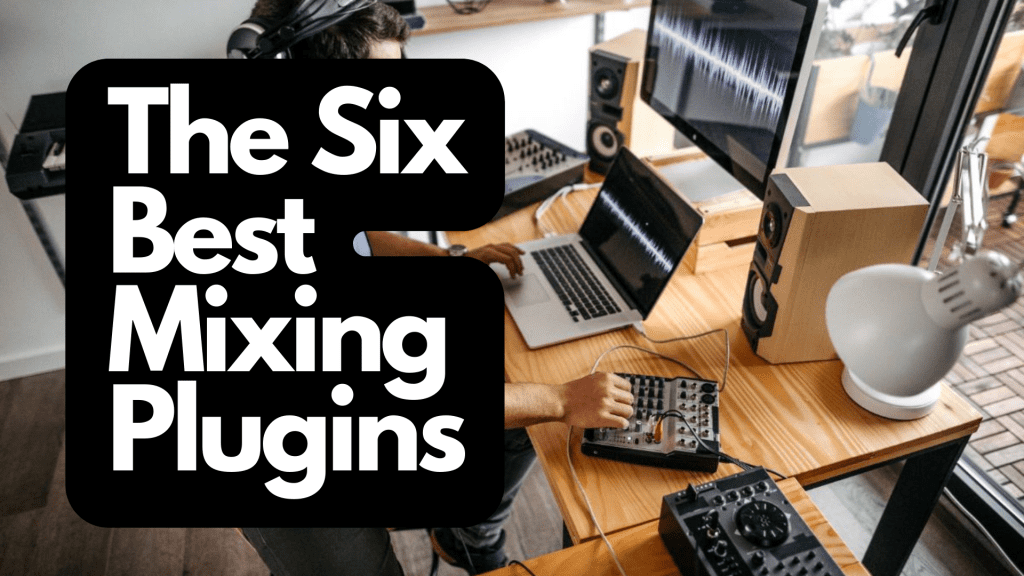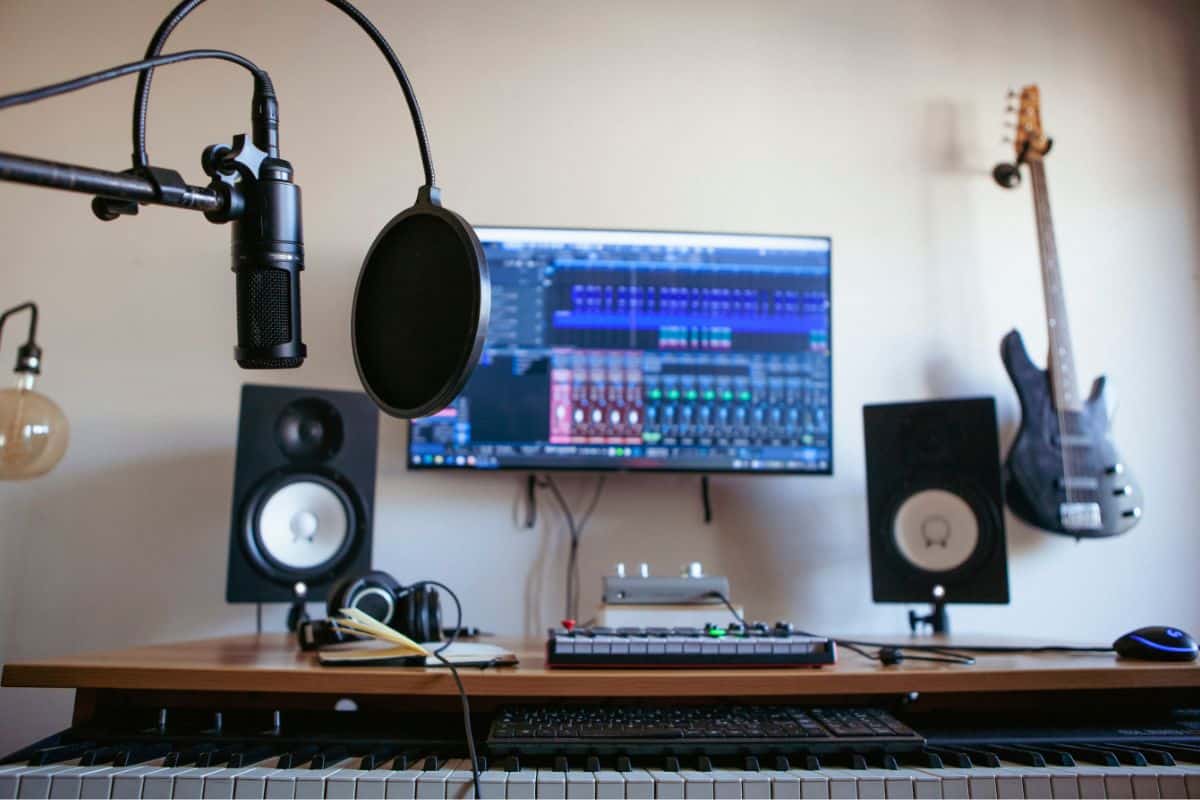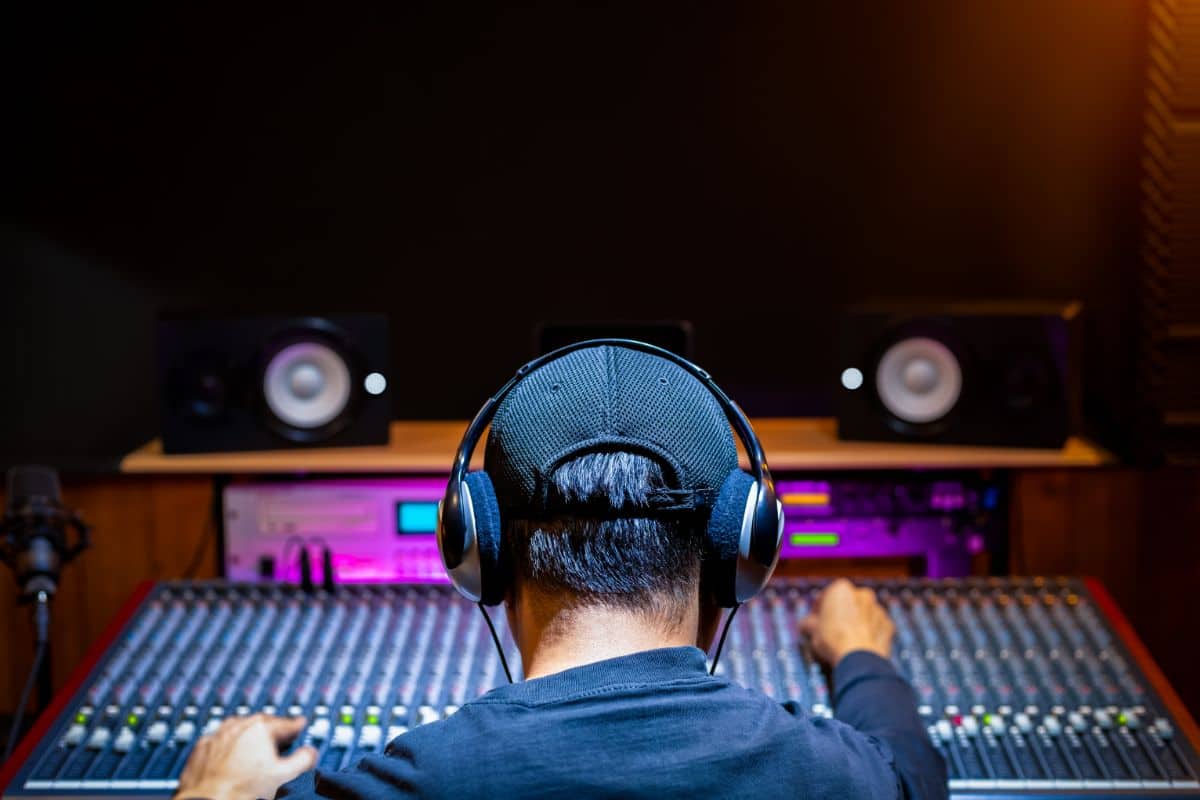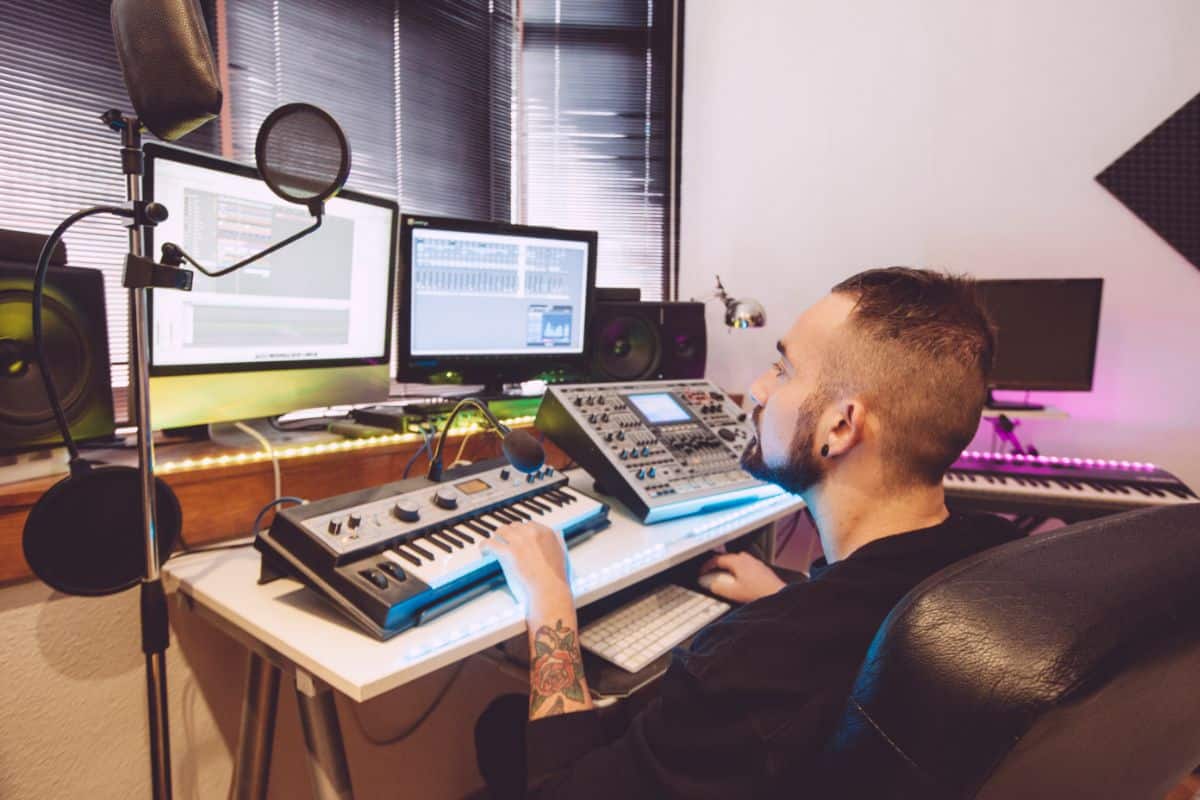Mixing is the process of blending different recorded tracks until they fit together, this is done using different tools and software.
Relative levels are adjusted and balanced with many processes added to the mix to change the sound of the track.

The end result is a solid and cohesive product that’s able to flow well and bring emotion to the audience.
Mixing occurs in a variety of different music genres across the globe.
Mixing music has become increasingly popular over the last decade with a huge number of music festivals, music schools and genres emerging.
When buying any new music equipment, you want to get value for money and a reliable product.
There are thousands of different mixing plugins on the market which can make it an overwhelming experience trying to decide.
Research is essential when it comes to this costly equipment.
Awarding a particular tool the label of ‘best mixing plugin’ is difficult as there is no one perfect solution to producing music.
There are multiple categories of plugins which perform different functions.
There are certain brands that are more reliable and reputable than others, but in this context, there isn’t an overall winner.
If you’re starting out making music, great job!
We know there’s a lot of information out there on the mixing process and what equipment to use, but fear not, we’ve narrowed it down for you.
What Is A Mixing Plugin?
‘Plugins’ are a common phrase in the tech world and they can be used in a number of different industries.
In the music industry, a mixing plugin refers to a tool that is plugged into a digital audio workstation (DAW).
This workstation is what producers use to record, edit and produce sound files and eventually, tracks.
Mixing plugins offer unique functions that the DAW doesn’t possess, allowing the producer to expand their creativity.
Typical plugins include equalization, dynamic range control, reverberation, delay and virtual instruments.
What Do Mixing Plugins Do?
As mentioned above, there are hundreds of different mixing plugins to choose from.
Breaking them down into their major categories makes it easier to identify them and explain what they do.
Dynamic Effects Processors
Otherwise referred to as dynamic effects, these processors are used to alter the volume or amplitude of a signal.
This helps to level things out and bring out any sounds that are too low in a mix.
Plugins associated with this category are compressors, limiters, noise-gates and De-essers
.
Time-Based Effect Processors
To manipulate the sound of the original audio over a period of time you need to use a time-based effect processor.
This commonly refers to reverb and delay and is used to help the listener’s perception of space within a mix so it sounds natural.
Reverbs are one of the most used mixing plugins as they help emulate real-world reverb to add depth and space to a mix alongside helping to smooth out any harsher sounds.
Typically, these types of processors are used on vocals, drums, guitars and pianos.
Filter Plugins
Filter plugins are essential for changing the loudness or amplitude of a signal, sharpening up the audio and creating individual track clarity throughout the mix.
Examples of filter plugins include an equalizer and a hi/lo pass filter.
Harmonic Effects Processors
Harmonic effects can also be referred to as audio saturation plugins and are designed to add “character” to your mix with warmth and color effects.
This produces sounds that seem like they’ve been through an analog processor giving an overall more vintage feel.
Plugins for these purposes include the saturation plugin and the distortion plugin.
Pitch Modification Plugins
These do what the name suggests. Usually, these effects are applied to vocals as this is where they tend to be needed.
But, they can also be used on instruments if it was recorded live.
When using a pitch plugin, you can double or multiply a sound to make it feel full and warm.
A pitch shifter/corrector, a harmonizer or a doubler can be used to change the pitch of a mix.
Modulation Effects Plugins
Lastly, modulation effect plugins can be used to change certain properties of an audio signal to produce a particular effect.
Those producing music use modulators such as low-frequency oscillators, step sequencers and standard envelopes to achieve this and are usually applied in the production stage rather than the mixing stage.
Best Mixing Plugins
Waves H-Delay Hybrid Plugin
Waves is a widely reputable company known for making excellent products. The Waves H-Delay is small but mighty.
Contained in an analog interface are a number of knobs and buttons that allow you to create a wide-ranging number of delay effects up to 3500ms with an old-school feel.
These include filtering, flanging, phasing, slap-back echo, ping-pong and so on. It also has inbuilt modulation and filtering.
The best feature of this product is the delay time itself which can be set in either milliseconds, BPM (beats per minute) or synced to the host tempo.
Alongside the great sound quality, the H-Delay is versatile and easy to use making it a highly popular product.
Many previous customers have a number of highly-rated reviews stating their delight with the product, especially how well it works with vocals. Others found it to be a reliable product at a good price.
Pros
- Long delay times of 3500ms
- Affordable price
- Very easy to tweak your work
- Easy and simple to use
Cons
- Basic ‘no frills’ equipment
- 31-bit plugin so may not work for those who only work with 64 bit
FabFilter Pro-R Reverb Plugin
The FabFilter Pro-R is a reverb software plugin that provides an incredibly realistic sound as the tracks you’re mixing are able to blend together without causing unnatural coloration or phase issues.
The Pro-R features a Retina interface that offers great versatility and is easy to use and set up coming in a range of sizes to suit the individual.
The non-technical controls allow you to alter brightness, character and distance to achieve the reverb sound you want to capture.
Room models for the Pro-R range from subtle, barely-there to large cathedral-like ambience enabling you to create a natural feeling sound.
The wide range of great-sounding reverbs is a real selling point of this product.
Using the industry-first Decay Rate EQ is a concept that mimics the decay time of a real room over the frequency spectrum.
This enables the user to shape the decay time characteristics.
The Pro-R has been widely recognized in the music industry with a number of different publications and artists giving it highly-rated reviews.
Praise for the easy-to-use features and flexibility occurs time and time again.
However, this is reflected in the price tag as this item can cost over $200.
Pros
- Simple and easy-to-use interface
- State-of-the-art decay rate
- Great distance feature
Cons
- More on the expensive side therefore not accessible for all users
- Can be CPU intensive if you’re not working on a designated music system
EQ: Pultec Passive Collection
Equalization or EQ is the process of adjusting the amplitude of specific frequencies in order to get a clear and balanced mix.
The Pultec has been an engineer and studio staple since the 60s.
In more recent years, newer items have been remodelled on the old. The most popular is the EPQ-1A.
The plugin is a reinvented version of their original analog hardware which was brought back into production by painstakingly reproducing the circuits.
Similar to the original, the 3U EQP-1A is solid and robust and features a large, spacious control panel with big knobs spread across it.
Based on the original hardware, running a full mix through it provides you with nostalgic Pultec analog magic.
You can create silky vintage highs and tight, focused lows using the combined boost and cut resonant shelf dip with this model which is considered the signature effect.
The unique curve created allows you to boost the low end whilst notching the frequency above.
These effects work perfectly with the bass guitar and drum kit.
Due to the cost of the Pultec products, they are really made for beginners starting out.
They are usually found in professional studios or bought by those with a lot of experience and disposable income.
Pros
- Authentic Pultec sound remodelled on the original product
- High-quality product
- Lower noise floor than the original product
Cons
- The painstaking work has made it a very costly piece of equipment
Universal Audio 1176 Compressor
Compression in terms of mixing refers to the process of reducing the dynamic range of a sound.
Put simply, this is the difference between the loudest and quietest sounds in a mix.
Compressions occur when the volume exceeds a specified level, such as when the chorus of a song begins the music behind it lowers in volume rather than overpowering it.
Another product that has been brought back into production is the 1176LN compressor.
It’s modelled on the original in terms of design, manufacturing and performance.
This FET (field-effect transistor) compressor is an analog plugin that utilizes a FET at the core of the circuit.
Often these are more fast-acting and offer greater transient preservation than other compressors.
The extremely fast attack (20 microseconds to 800 microseconds) and release times make it ideal for taming sharp peaks and transients that come with certain sounds or instruments like a snare drum.
Pushbutton selections can also be found for a selection of compression ratios making for easy, simple use.
When products are carefully replicated from the past the cost goes up 1176 is no exception.
That said, this is an emulation of a classic, reliable and great mixing plugin.
Competitors have tried to replicate this tool, so it is possible to get one for a fraction of the price that works well.
Pros
- Simple and easy to use
- Great sounding compressor
- Makes vocals and instruments sound amazing
Cons
- Can get very aggressive with the fast release
- Expensive – not everyone can afford this
Waves SSL E-Channel Plugin
Downloadable plugins such as this provide 4-band parametric EQ plus highpass and lowpass filters.
Other features include a soft-knee compressor/limiter as well as an expander/gate.
This type of plugin is highly recommended for drum sounds.
The equalization section of the SSL E-Channel is based on the rare and highly-regarded Black Knob equalizer.
The dynamics section is modelled on the SSL LS611E, as with the original plug-in it allows you to place dynamics before or after the EQ section.
Online this SSL400E console channel strip emulation is highly regarded throughout the industry alongside a number of customer reviews which all stated this plugin was highly effective and sounded great.
Pros
- Great sounding emulation of SSL channel strips
- Resizable interface and graphics make for easy and pleasurable use
- Reasonable price
Cons
- Can’t use one licence with multiple computers
- Certain sounds can be quite harsh
XLN RC-20 Retro Color
This saturation plugin has 6 effect modules that can work alone or simultaneously to create feelings of warmth usually created from using vintage recording equipment.
These include noise generator, wobble and flutter, saturation and distortion, degrader and bitcrusher, reverb and volume drops.
Adding texture is simple with the RC-20, as there are many different noise types to choose from such as a tape hiss, a vinyl crackle to static noise.
Presets have been adapted to use on instruments such as the drums, keys and guitar as well as in a post-production context.
Impressively, the RC20 has won a number of Computer Music Innovation awards.
Coupled with the glowing reviews you’ll find online, it’s easy to see why this plugin is so popular.
Despite what you may think, it can be purchased for a very reasonable price.
Pros
- A wide range of very good presets
- Very good value for money
- Excellent sound quality
- Easy to use and attractive interface
- Beautifully effective processors
Cons
- The space module seems unnecessary
Best Mixing Plugins Buyers Guide
Before purchasing your new mixing equipment there’s no need to spend hours researching, simply refer back to this article.
Type Of Product
Do you prefer to use a physical product or some easily downloadable software?
Many modern plugins are easily downloadable online when you’ve purchased the appropriate license.
However, some people like to physically touch buttons and twist knobs when mixing.
The specific mixing plugin you purchase will depend on your specific needs and what you need the equipment to do.
If you’re new to mixing, you may want to get the basics: EQ, Compression and Reverb as these three plugins account for around 90% of the mix.
Some may have a specific product in mind but don’t know which brand to choose from.
Always have a clear idea of what tool you need before you make a purchase.
User Interface
As you’re going to be using the equipment a lot, you need to make sure that it has an easy-to-use interface that also provides a pleasurable user experience.
If you’ve bought a plugin that is complicated and stresses you out when you use it, then you’re less likely to.
Many of the modern plugins have attractive interfaces which can even be resized to suit you.
Spending money on a tool that you end up hating is all the more crushing when you’ve spent your hard-earned money on it.
All of the products included here have all been highly rated in terms of interface usage.
Price
One of the main factors that influence a buyer on their journey is price.
Although we’ve featured some very reasonably priced products here, sometimes the price can fluctuate.
In particular Waves products often go on sale, so keeping an eye on what deals are out there is essential to finding a good deal and getting the most out of your money.
We’ve included some of the more expensive plugins due to their highly regarded reputations and impacts in their fields.
Unfortunately, sometimes you do have to pay for quality as these tend to be more intricate and expensive to produce and hard to come by.
Emulations of these products can be found online if you do some extra research or look at a secondhand option.
Final Thoughts
As you can see there is a lot to consider when purchasing a mixing plugin.
We hope you found this article helpful and informative when choosing your next tool. Happy mixing!
Frequently Asked Questions
What Plugins Do You Use For Mixing?
There are hundreds of different mixing plugins available.
Depending on what you’re aiming for with your music depends on which plugin you’ll need to use.
For example, if you want to change the volume or amplitude of your signal you’ll need to use a dynamic processor such as a compressor.
What Plugins Make Your Voice Sound Better?
The UAD 1176 linked in this article is the most widely used FET limiting amplifier which works perfectly on vocals, whether they are real or not.
One of the great qualities of this plugin is the ability to add character to the vocals.
Recent Posts
QuickTime is a vital app for many Mac users, and if you’ve recently bought a new microphone, you might wonder how to use it optimally. QuickTime cannot record audio content if it doesn’t have...
Every microphone leaves a unique signature on the quality of its output. If you’re a podcaster trying to melt your way into your audience’s hearts, a muddy, distorted recording won’t cut it....







